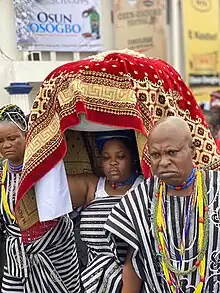Osun-Osogbo
Osun-Osogbo is a sacred grove along the banks of the Osun river just outside the city of Osogbo, Osun State of Nigeria.
| UNESCO World Heritage Site | |
|---|---|
 First Palace In Osun-Osogbo Sacred Groove | |
| Location | Osogbo, Nigeria |
| Reference | 1118 |
| Inscription | 2005 (29th Session) |
| Area | 75 ha (190 acres) |
| Buffer zone | 47 ha (120 acres) |
| Coordinates | 7°45′20″N 4°33′08″E |
 Location of Osun-Osogbo in Nigeria | |

The Osun-Osogbo Grove is several centuries old[1] and is among the last of the sacred forests that once adjoined the edges of most Yoruba cities before extensive urbanization. In recognition of its global significance and cultural value, the Sacred Grove was inscribed as a UNESCO World Heritage Site in 2005.[2]
The 1950s witnessed the desecration of the Osun-Osogbo Grove: shrines were neglected and priests abandoned the grove as customary responsibilities and sanctions weakened. Prohibited actions like fishing, hunting and falling of trees in the Grove was done indiscriminately until an Austrian national named Susanne Wenger (1915-2009)[3] helped to reinstate traditional protections.[4]
With the support and encouragement of the Ataoja (the royal king of the time) and the support of the concerned local people. Wenger "formed the New Sacred Art movement to challenge land speculators, repel poachers, protect shrines and begin the long process of bringing the sacred place back to life by establishing it again, as the sacred heart of Osogbo".[5] Wenger later came to be honoured the titled "Adunni Olorisha" for her custodial efforts and her consistent devotion to the gods of the grove.
Osun-Osogbo Festival
Ever since that year, the Osun-Osogbo Festival has been celebrated in August at the Grove. The festival attracts thousands of Osun worshippers, spectators and tourists from all over the world.
History of the Festival
Osun-Osogbo Festival is believed to have a history of more than 700 years. Historically, an ancestral occurrence led to the celebration of this festival. Once upon a time, a group of migrants who were led by a great hunter called Olutimehin settled on the bank of the Osun river to save themselves from famine. On the river-side, Yeye Osun the river goddess appeared from the water in front of Olutimehin and requested him to lead people to a special place (the present-day Osogbo town).[6] The goddess promised to protect the group and bring them prosperity in return for an annual sacrifice to her. The group accepted the proposition, and today the annual sacrifice to the Osun River Goddess is still celebrated as the Osun-Osogbo Festival.[7]
Celebrations
In modern times, August is a month of celebration for the people of Osogbo land that includes the traditional cleansing of the city and the cultural reunion of the people with their ancestors, the founders of the Osogbo Kingdom.[8]
The Osun-Osogbo Festival itself is a two-week-long programme. The traditional cleansing of Osogbo is called 'Iwopopo', which is followed after three days by the lighting of the 500-year-old sixteen-point lamp called 'Ina Olojumerindinlogun'(16 face lamp). Then comes the 'Iboriade', an assemblage of the crowns of the past rulers, the Ataojas of Osogbo, for blessings.
The Festival culminates in a procession to the shrine in the sacred grove where a large crowd builds up. Drumming, dancing, musical performing, wearing elaborate costumes, speaking of the Yoruba language, recitation of praise poetry, and so on add pomp and colour to the proceedings. This event is led by the sitting Ataoja of Osogbo along with a ritualized performer called the Arugba(calabash carrier) and a committee of priestesses, who reenact the very first meeting between Oluwatimilehin and Yeye Osun.[9] Arugba is played by a young woman of a kingly lineage who offer the sacrifice to the deity.
In 2020, the procession was limited to the ritual performers and public participation was suspended due to COVID-19.[10]

Benefits of the Festival
The festival is of immense benefit to the tourism sector of Nigeria. It enables the community to sell its culture to tourists coming from both within the country and from all over the world.[11]
The Osun-Osogbo festival also serves as a strong unifying factor in Osogbo land, as irrespective of the different social, economic, religious and political convictions of the people, they all come together annually to celebrate the goddess.[11]
Gallery






References
- "Osun-Osogbo Sacred Grove".
- Peter Probst. Osogbo and the Art of Heritage. Monuments. Deities, and Money. Bloomington: Indiana University Press, 2011.
- "Susanne Wenger, a decade after the glow". The Guardian Nigeria News - Nigeria and World News. 2019-09-15. Retrieved 2022-06-03.
- Peter Probst. "Modernism against Modernity. A Tribute to Susanne Wenger." Critical Interventions, Journal of African Art History and Visual Culture, 2009, No.3/4, 245-255. Peter Probst. "From Iconoclasm to Heritage. The Osogbo Art Movement and the Dynamics of Modernism in Nigeria." A Companion to Modern African Art. Edited by Gitti Salami and Monica Blackmun Visona (eds.) Malden, MA: Wiley-Blackwell, 2013, pp. 294-310.
- "Osun Osogbo: Carnival of culture in a sacred forest". The Punch - Nigeria's Most Widely Read Newspaper. Archived from the original on 3 June 2015. Retrieved 18 August 2015.
- Oyintiloye, Olatunbosun (23 September 2012). "What you did not know about Osun Osogbo". Vanguard. Retrieved 9 October 2022.
- Agu, Zain (2018-08-07). "When will Osun Osogbo festival be this year?". Legit.ng - Nigeria news. Retrieved 2019-08-19.
- "About - Osun Osogbo Festival". osunosogbofestival.com. Retrieved 18 August 2015.
- Fasan, Rotimi (2016-09-01). "Arugba: superwoman, power and agency". Journal of African Cultural Studies. 28 (3): 283–291. doi:10.1080/13696815.2016.1163254. ISSN 1369-6815.
- "Oun Osogbo government bans procession allows only worshippers to shrine". Vanguard.
- "THE OSUN OSOGBO FESTIVAL (ITS FUNCTIONS AND AESTHETICS)". myproject.com.ng. Retrieved 11 November 2017.
External links
- Sacred Orisa Gardens of the West
- Osun Osogbo Sacred Grove- UNESCO
- Ijele: Art Ejournal of the African World
- Osun Osogbo, the film
- Lady from Osogbo, long feature film
- Oshunfilm
- Osun-Osogbo Sacred Grove